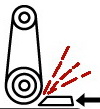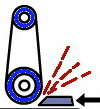DUST EXTRACTION
Any process that abrades material generates dust. Dust that isn’t collected can damage the surface finishes you want to achieve, the moving parts of the machine, your operators’ lungs and those working in the vicinity, and, in extreme cases with white metal dusts, it can even explode.
Dust NEEDS to be collected.
Collection of airborne dust takes two general forms: dry or wet.
- The dry method typically involves sucking the dust laden air through filter bags. There are many options available to add to this technique: spark traps, auto shake down, secondary High Efficiency (HEPA) filters, dust bags and bins for collection. Choices depend on the dust, the volumes and the duty.
- A common variation is the cyclone filter for heavy dust loadings. No bags, and few moving parts but at the expense of particle size efficiency.
- Wet collection involves drawing the dust laden air through a sump of water, eliminating all fire hazards. Again there are many options for different circumstances.
But for the extractor to be efficient it needs to be matched to the correct ductwork. Correct in terms of diameter, wall thickness (e.g. 2mm/14g when dealing with explosive dusts), distance from source of dust, number of bends, position of inspection hatches, etc.
And where should you site the extractor? Inside your factory? Outside? Next to the source of the dust?
Profimach can advise and help at all stages, with selection, installation, maintenance.

